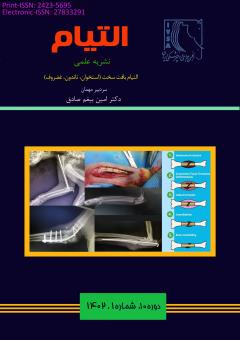مروری بر روش های کواپتاسیون خارجی در دام های کوچک
محورهای موضوعی : علوم جراحی دامپزشکی شامل جراحی های بافت های سخت و نرم
پوریا الماسی
1
![]() ,
ابوتراب طباطبایی نایینی
2
,
ابوتراب طباطبایی نایینی
2
1 - دانشجو، بخش علوم درمانگاهی دانشکده دامپزشکی دانشگاه شیراز ، شیراز ، ایران
2 - استاد، بخش علوم درمانگاهی، دانشکده دامپزشکی دانشگاه شیراز، شیراز، ایران
کلید واژه: کواپتاسیون خارجی , بانداژ , دام کوچک , بانداژ , آتل , گچگیری , اسلینگ,
چکیده مقاله :
تثبیت خارجی توسط کواپتاسیون به معنای استفاده از گچها، آتلها، بانداژها و اسلینگ ها برای بی حرکت کردن اندام آسیب دیده است. این روش ها اگر درست بکار روند به شکل تقریبی اندامی که روی آن اعمال می شوند هستند و تثبیت پایدار قطعات استخوان را بدون نیاز به ایمپلنت های جراحی در محل شکستگی فراهم می کنند. تثبیت خارجی آسیب های ارتوپدی در دامپزشکی مزایای قابل توجهی نسبت به تثبیت باز(open fixation) و تثبیت داخلی(internal fixation) دارد. در بیشتر موارد، آسیب های بافتی و عروقی، خطر عفونت و هزینه استفاده از آن می تواند بسیار کمتر از مداخلات جراحی باشد. موفقیت درمان بستگی به انتخاب روش درمانی مناسب برای بیمار دارد. روش های تثبیت موقت معمولاً برای پیشگیری از ادم، تسکین درد، کاهش آسیب بعدی به بافت نرم، محافظت از زخم در برابر آلودگی بیشتر، جلوگیری از تبدیل شکستگیهای بسته به شکستگیهای باز و تثبیت شکستگی در حیواناتی که بصورت حاد آسیب دیده اند کاربرد دارد. در دامپزشکی انواع مختلفی از کواپتاسیون خارجی برای ایجاد بهترین تثبیت خارجی آسیب ها در دسترس است، پس برای فعالین این حوزه ضروری است که با روش های مختلف و موارد استفاده از آن ها آشنایی کافی داشته باشند.به عنوان یک قانون کلی کواپتاسیون خارجی روشی قابل قبول برای ترمیم شکستگی در بیماران جوان (کمتر از 1 سال) است زیرا سریعتر بهبود می یابند. کواپتاسیون خارجی به بهترین وجه نیروهای خمشی روی شکستگی های دیستال را خنثی می کند و نیاز به تثبیت مفصل بالا و زیر شکستگی دارد؛ بنابراین، کواپتاسیون دارای معایبی از جمله بی حرکتی طولانی مدت اندام است که خود می تواند باعث آتروفی شدید ناشی از "آتروفی عدم استفاده(disuse atrophy)" و احتمالا "بیماری شکستگی(fracture disease)" شود.
External fixation by means of coaptation means using casts, splints, bandages, and slings to immobilize the injured limb. These methods if used properly approximate the shape of the limb on which they are applied and provide stable fixation of bone fragments without the need for surgical implants at the fracture site. External fixation of orthopedic injuries in veterinary medicine has significant advantages over open fixation and internal fixation. In most cases, the soft tissue and vascular damages, the risk of infection, and the cost of its use can be much lower than surgical intervention. Careful case selection is required to achieve successful treatment of fractures with external coaptation. Temporary fixation methods are usually used to prevent edema, relieve pain, reduce subsequent soft tissue damage, protect the wound from further contamination, prevent the conversion of closed fractures to open fractures, and stabilize the fractured particles in acutely injured animals. Various types of External coaptations are available in veterinary practice to provide the best external fixation of injuries. Therefore, it is essential for the practitioners in this field to have sufficient familiarity with different methods and their uses. As a general rule, external coaptation is an acceptable mode of fracture repair for animals that are younger than 1 year of age, because they heal faster. External coaptation best neutralizes flexion forces on distal fractures and requires stabilization of the joint above and below the fractured site. Therefore, coaptation has the disadvantage of prolonged immobilization of the limb, which can cause severe atrophy from "disuse atrophy" and possible "fracture disease".
1. Oakley RE. External Coaptation. Veterinary Clinics of North America: Small Animal Practice. 1999:1083-95.
2. Bojrab MJ, Don Ray Waldron , James P. Toombs. Orthopedic Bandaging and Splinting Techniques. Current Techniques In Small Animal Surgery Ed 5: Tenton NewMedia; 2014. p. 1119-33.
3. Muir P, Norris J. Metacarpal and metatarsal fractures in dogs. Journal of small animal practice. 1997;38(8):344-8.
4. Slatter D. Textbook of Small Animal Surgery, 3rd Edition. philadelphia: saunders; 2002.
5. Schwarz PD. Biomechanics of fractures and fracture fixation. Semin Vet Med Surg Small Anim. 1991;6(1):3-15.
6. Leighton RL. Principles of conservative fracture management: splints and casts. Semin Vet Med Surg Small Anim. 1991;6(1):39-51.
7. Weinstein J, Ralphs SC. External coaptation. Clinical Techniques in Small Animal Practice. 2004;19(3):98-104.
8. Tomlinson J. Complications of fractures repaired with casts and splints. Vet Clin North Am Small Anim Pract. 1991;21(4):735-44.
9. Beardsley SL, Schrader SC. Treatment of dogs with wounds of the limbs caused by shearing forces: 98 cases (1975-1993). J Am Vet Med Assoc. 1995;207(8):1071-5.
10. Stocker B BC, Rohner-Spengler M, Müller UW, Meichtry A, Luomajoki H. Effective therapy to reduce edema after total knee arthroplasty multi-layer compression therapy or standard therapy with cool pack—a randomized controlled pilot trial. Pflege 31 2018:19–29.
11. Fossum TW. SMALL ANIMAL SURGERY, FIFTH EDITION. Philadelphia: Elsevier; 2019.
12. Amelia M. Simpson MR, Brian S. Beale. Bandaging in Dogs and cats : external coaptation. Compendium. 2001:157-64.
13. Charles E. DeCamp SAJ, Loïc M. Déjardin, Susan L. Schaefer. Treatment of Fractures, Lameness, and Joint Disease. In: Charles E. DeCamp SAJ, Loïc M. Déjardin, Susan L. Schaefer,, Brinker PaFsHoSAOaFRFE, Saunders WB, editors. Handbook of SMALL ANIMAL ORTHOPEDICS AND FRACTURE REPAIR, FIFTH EDITION. Missouri: Elsevier; 2016. p. 24-152.
14. Piya Pinsornsak SC. Can A Modified Robert Jones Bandage After Knee Arthroplasty Reduce Blood Loss? A Prospective Randomized Controlled Trial. Clin Orthop Relat Res. 2013:1677–81.
15. Bartels K. Mechanical Testing and Evaluation of Eight Synthetic Casting Materials. Veterinary Surgery. 1985:310-8.
16. P.D. Marshall AKD, T.H. Walters, D. Lewis. When should a synthetic casting material be used in preference to plaster-of-Paris? A cost analysis and guidance for casting departments. Injury. 1992:542-4.
17. Swaim SF VD, Spalding PJ, Riddell KP,. Evaluation of the dermal effects of cast padding in coaptation casts on dogs. American Journal of Veterinary Research. 1992:1266-72.


